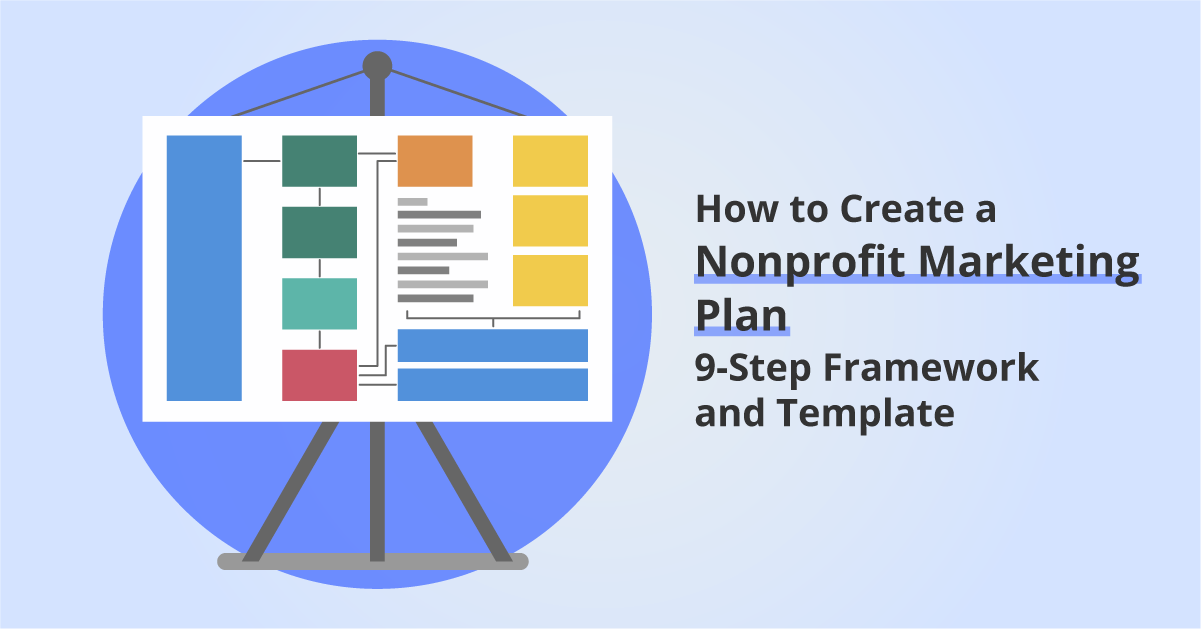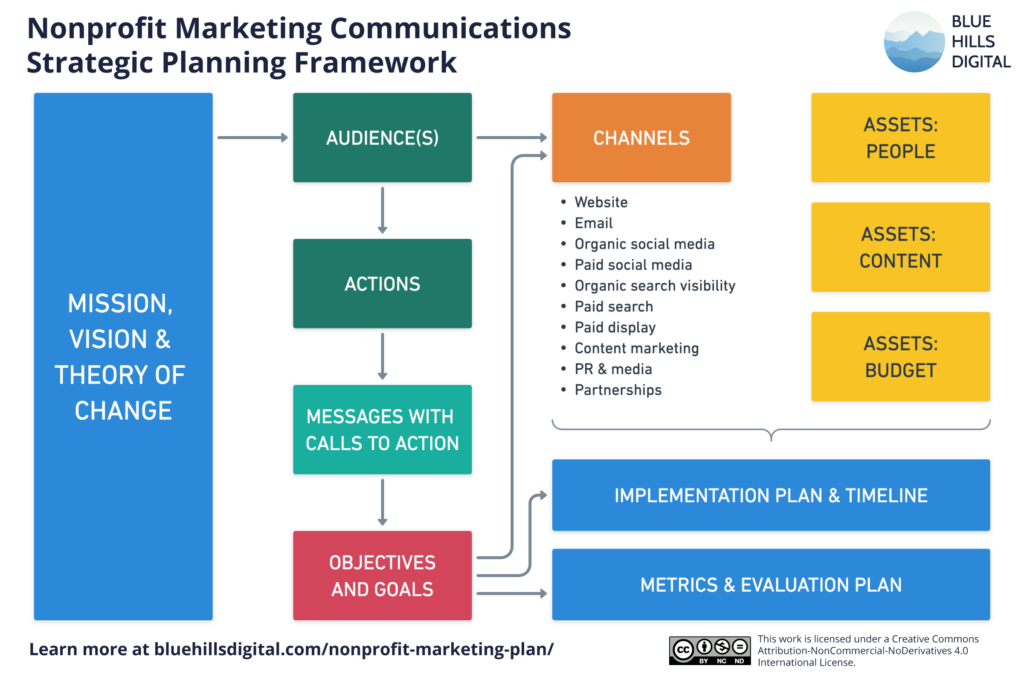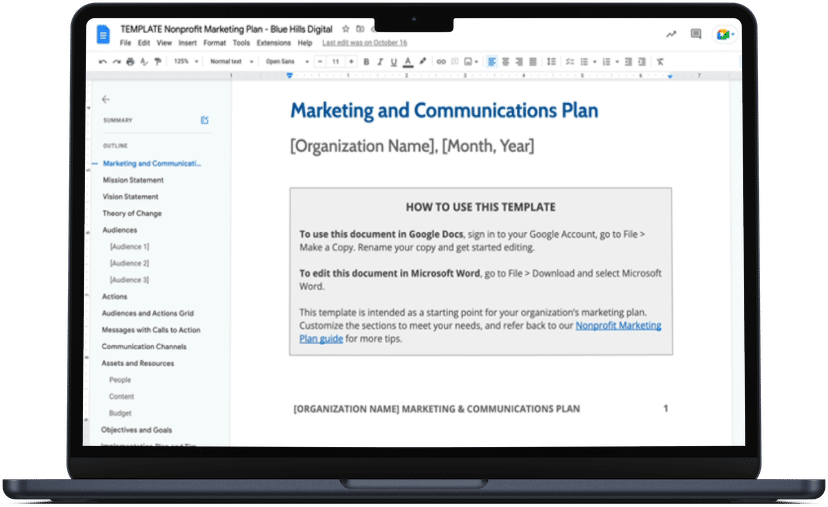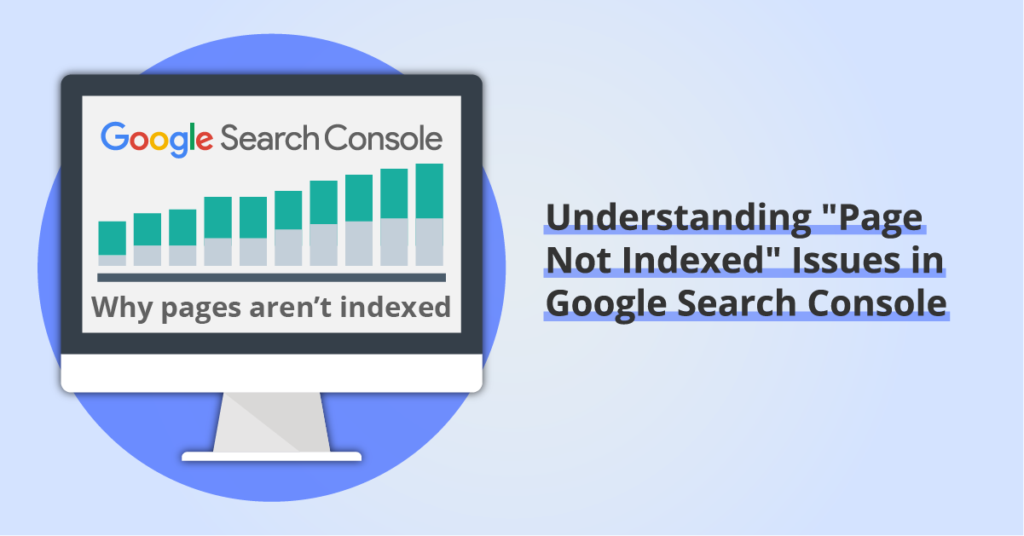How to Create a Nonprofit Marketing Plan: 9-Step Framework and Template
By: Ed Harris / Published: October 16, 2022 / Last updated: June 28, 2024

Developing a marketing plan for your nonprofit is often a daunting task, especially when team members with marketing or communications responsibilities are busy keeping up with social media, email newsletters, and website updates.
But carving out some time to create a strategic marketing communications plan with clear objectives and goals is worth the effort.
In this guide, we introduce the nonprofit marketing strategy framework we use to help nonprofit leaders navigate the marketing planning process. We’ll also share a downloadable template you can use to streamline your planning process.
Why is a Marketing Plan Important for your Nonprofit?
If you are a nonprofit marketing leader, you may be in the position of having to convince other members of your leadership team that devoting time to marketing strategic planning is worthwhile.
Or perhaps you’ve been asked to lead the creation of a marketing strategic plan and you’re not sure where to start.
Before we jump into the process, let’s look at why a marketing or communications strategic plan can be such a powerful tool for your organization.
- Taking time for marketing communications strategic planning forces you to step back from day-to-day marketing activities and consider how marketing fits into broader organizational objectives. You’ll find yourself having higher-level, strategic conversations with other teams within your organization, to understand how marketing can support their work. As a nonprofit marketing or communications professional, you’ll often come away from the strategic planning process with a better understanding of how your work fits in to the organization as a whole.
- Creating a marketing plan encourages you to establish specific objectives and goals. Since so much of effective marketing is about running experiments to see what works, having clear goals and measurement plans allows you to get better and running experiments and learning from the results. Over time, goals and measurement plans will help you become a more effective marketer.
- Developing a marketing plan brings clarity about how much you can realistically achieve within your current resource constraints, meaning people, time, and budget. Once you understand the connection between marketing success and resources, you will be in a stronger position to advocate for more people, time, or budget when your organization’s marketing objectives require it.
Disclosure: some of the links below are affiliate links, meaning that at no cost to you, we will earn a commission if you click through and make a purchase. Learn more about the products and services we recommend here.
Marketing vs. Communications Planning
The distinction between marketing and communications here is messy. This is reflected in job titles for nonprofit staff with marketing or communications responsibilities. It’s also reflected in what we call the work described in this article, which could creating a:
- a marketing plan,
- a communications plan, or
- a marketing (and) communications plan.
The terms marketing and communications are often used interchangeably in the nonprofit sector, and often without clearly distinct meanings.
Here’s how we view the difference:
- Marketing starts with the audience. Marketing seeks to understand the viewpoint or needs of the audience, and pull them into engagement with the product or service, or in the case of a nonprofit, taking actions aligned with the mission-driven work of the organization.
- Communications starts with the organization. Whereas marketing materials will include lots of “you” language, communications speaks from the organizational perspective, pushing out information or statements with more “we”, “us” and “our” language.
In reality, marketing and communications go hand in hand. To be effective, you both need to consider the audience’s needs and find marketing messages and channels that will pull them in to your work. But you will also need to communicate about your work, pushing out information about the urgency of the work, the challenges you face, and your successes.
Viewpoints on this will vary. In our consulting work, we think of communications as an essential element within a broader marketing plan. If it wasn’t so long and cumbersome, this article would refer to a Marketing Communications Strategic Plan, because that’s what it’s really about.
More Reading:
David Williamson of Bernuth & Williamson has a helpful article on the topic of nonprofit marketing vs. communications. You can find the PDF at this link.
Now on to the framework, and how to start planning.
9-Step Framework for Nonprofit Marketing Strategic Planning
The diagram below captures our current thinking about the components involved in marketing communications planning, and how they are related to each other. We’ll review each of these components below, and you’ll find spaces for each in the Nonprofit Marketing Plan Template available for download on this page.

This framework isn’t set in stone. At least once every few months, something is added or adjusted. But it’s probably 80% of the way there.

Nonprofit Marketing Plan Template
Get your Marketing Plan Template, available to edit in Google Docs or Microsoft Word:
Unsubscribe at any time. Privacy Policy and Terms of Use apply.
1. Start with your Mission, Vision, and Theory of Change
We start in the big blue box on the left, filling in your organization’s mission, vision, and theory of change. Hopefully these statements already exist — perhaps in your organization’s founding documents or the most recent organization-wide strategic plan.
This information is a critically important starting point.
- The Mission Statement describes what change the organization wants to effect in the world.
- The Vision Statement describes what that changed world would look like.
- The Theory of Change captures your organization’s understanding of how your work can make that change happen.
If these starting points aren’t clearly defined already, your organization may be in need of some higher-level strategic planning, and it will be trickier to develop a robust marketing plan that is tied to organizational objectives.
2. Define Audiences
As we said above, marketing starts with knowing your audience. Your nonprofit likely has several distinct audiences that the organization needs to market to and communicate with. For example, audiences may include:
- Community members that use your services or programs
- Current or potential donors
- Policy makers and elected officials
- Funders
- Journalists or thought leaders active in your sector
Ideally you can use some brainstorming activities to reduce your list of potential audience members down to 2 or 3 broad audiences. Once you have defined these broad audiences you can use them to proceed through to the next steps of the planning process.
For more tips on identifying and clarifying your audiences, check our guide to developing audience personas.
3. What Actions do you want Audience Members to Take?
Next you’ll need to identify what actions you want members of each of the audiences defined above to take as they engage with your organization.
For example, if you have a donor audience, the primary action will be for them to provide financial support through making a first-time donation or increasing their giving.
4. Develop Action-Oriented Messages
Step 4 ties steps 2 and 3 together by creating boilerplate messages to use when speaking to audience members. These messages will encourage them to take the target actions identified above.
In the example considered above, you would need to develop messaging that starts from your donor audience’s point of view and helps them understand how providing financial support to your organization will help them be engaged in your issue area.
5. Consider your Communication Channels
Next, we need to pause and consider what communication channels we should prioritize in your marketing plan. The most important factor here is understanding where your audience members “spend time.”
For example, for an organization involved in advocacy at the federal level, policy-makers and journalists will be an important audience. In turn, this might lead you to prioritize Twitter and an active media relations program over Facebook or content marketing.
Here’s a list of communication channels we use as a starting point for this conversation:
- Website (read more about must-have features for nonprofit websites here)
- Email (read more about email marketing for nonprofits here)
- Organic social media
- Organic search (read more about SEO for nonprofits here)
- Paid social media advertising
- Paid search advertising (read more about free search advertising through Google Ad Grants here)
- Paid display advertising
- Content marketing
- PR & media
- Partnerships
At this stage it’s often helpful to conduct a communications audit to review what channels your organization already has set up.
6. Review your Communications Assets: People, Content, and Budget
Before jumping into setting goals, we need to review what assets you and your team have available. It’s helpful to think of this in three categories:
- People’s time and skills. Consider the number of staff people (or volunteers) that have skills or expertise in marketing and the number of hours they can devote to marketing and communications each week. This is often the most significant constraint on your marketing goals.
- Content. Review what existing content you have that can be used, adapted, or repurposed in future marketing and communications efforts. On a similar track, consider what types of content (written, video, audio, etc.) you would easily be able to produce using existing resources.
- Budget. As you plan to expand your marketing efforts, you may need to advocate for an increased investment in marketing tools, personnel, or advertising. Start with a clear understanding of how much your existing marketing infrastructure costs your organization so that you can effectively tie future expansions in marketing effort to the budget increases that may be needed to support that work.
7. Define Objectives and SMART Goals
Finally, after mapping out audiences, actions, channels, and your resource landscape, it’s time to establish objectives and create some SMART goals.
The way you approach this section will depend on the scope of your marketing plan. In some cases, you may be creating a high-level, multi-year marketing strategic plan. If that’s the case, we recommend setting high-level, ongoing objectives and establishing goals that will move towards those objectives in one-year increments.
If you are working towards a one-year plan, break goals down into quarterly increments.
If the plan is for a specific time-limited campaign or to market an upcoming event, your goals and timeline will be even more fine-grained and detailed, often broken up week-by-week.
When we provided marketing strategy consulting, we use two methods to establish objectives and goals. A full explanation of these methodologies is beyond the scope of this guide, so we’ll link to some helpful resources below.
To set objectives, we use the Objectives > Goals > Strategies > Measures (OGSM) methodology, where:
- Objectives define your overarching vision; the outcomes you would like to reach when the plan implementation period is over.
- Goals are specific descriptions that capture how you know you’ve reached your objectives. We use SMART goals here – goals that are:
- Specific
- Measurable
- Attainable
- Relevant
- Time-bound
- Strategies are the concrete steps or activities that you plan to take to reach your goals.
- Measures let you check along the way to determine whether your strategies are working in driving progress toward your goals.
More reading about OGSM:
- OGSM Frameworks: Making Your Strategy a Reality (MindTools)
- Introducing the OGSM model framework (Smart Insights)
More reading about SMART goals:
8. Create your Marketing Implementation Plan and Timeline
Once you have established SMART goals it’s time to create a calendar and use your project management tools to assign work among the team. This summary level plan and timeline should allow you to quickly check in and see both what marketing tasks should be taking place within a given time period, AND check on what progress you were hoping to achieve as time passes.
The tools you use to organize and share your marketing implementation plan and calendar will vary depending on the tools your organization already uses.
9. List your Metrics and Make an Evaluation Plan
At the goal-setting stage, you will have established some important metrics or key performance indicators (KPIs), along with timelines to assess progress. The evaluation stage is where you plan what your evaluation and reporting activities will be as the marketing plan is implemented.
Include information about who will check and record metrics, where they will be recorded, and how reports will be compiled and shared.
Ensure that you have the technologies in place to collect the data you need for effective evaluation. This may include some of the following items:
- Google Analytics (or an alternative analytics tool) to measure website traffic and conversions (find more information about website analytics for nonprofits here)
- Access to analytics from your social media platforms. Some social media scheduling tools include features that aggregate social media performance data which can streamline this process.
- A dashboard creation tool, like Google Data Studio or Databox. These tools can connect to your various marketing channels and pull data in automatically, saving some time over manual data entry.
Use our Free Nonprofit Marketing Plan Template
To help make your marketing planning process easier, we’ve prepared a template document for you to download. The template each of the sections reviewed above, and is fully editable in Google Docs or Microsoft Word. Complete the form here and we’ll send you the link to create your copy.
Need professional support with your nonprofit marketing strategy?
We work with nonprofit communications pros and mission-driven marketers. Book a free consultation and we’ll walk you through the strategy framework we use to develop marketing and communication plans.
Need help creating your nonprofit marketing strategy?
Schedule a free consultation to learn more about how to get the support you need.




